Jing Lu
Kuaishou
Auditory Attention Decoding from Ear-EEG Signals: A Dataset with Dynamic Attention Switching and Rigorous Cross-Validation
Oct 22, 2025Abstract:Recent promising results in auditory attention decoding (AAD) using scalp electroencephalography (EEG) have motivated the exploration of cEEGrid, a flexible and portable ear-EEG system. While prior cEEGrid-based studies have confirmed the feasibility of AAD, they often neglect the dynamic nature of attentional states in real-world contexts. To address this gap, a novel cEEGrid dataset featuring three concurrent speakers distributed across three of five distinct spatial locations is introduced. The novel dataset is designed to probe attentional tracking and switching in realistic scenarios. Nested leave-one-out validation-an approach more rigorous than conventional single-loop leave-one-out validation-is employed to reduce biases stemming from EEG's intricate temporal dynamics. Four rule-based models are evaluated: Wiener filter (WF), canonical component analysis (CCA), common spatial pattern (CSP) and Riemannian Geometry-based classifier (RGC). With a 30-second decision window, WF and CCA models achieve decoding accuracies of 41.5% and 41.4%, respectively, while CSP and RGC models yield 37.8% and 37.6% accuracies using a 10-second window. Notably, both WF and CCA successfully track attentional state switches across all experimental tasks. Additionally, higher decoding accuracies are observed for electrodes positioned at the upper cEEGrid layout and near the listener's right ear. These findings underscore the utility of dynamic, ecologically valid paradigms and rigorous validation in advancing AAD research with cEEGrid.
GLM-4.5: Agentic, Reasoning, and Coding (ARC) Foundation Models
Aug 08, 2025Abstract:We present GLM-4.5, an open-source Mixture-of-Experts (MoE) large language model with 355B total parameters and 32B activated parameters, featuring a hybrid reasoning method that supports both thinking and direct response modes. Through multi-stage training on 23T tokens and comprehensive post-training with expert model iteration and reinforcement learning, GLM-4.5 achieves strong performance across agentic, reasoning, and coding (ARC) tasks, scoring 70.1% on TAU-Bench, 91.0% on AIME 24, and 64.2% on SWE-bench Verified. With much fewer parameters than several competitors, GLM-4.5 ranks 3rd overall among all evaluated models and 2nd on agentic benchmarks. We release both GLM-4.5 (355B parameters) and a compact version, GLM-4.5-Air (106B parameters), to advance research in reasoning and agentic AI systems. Code, models, and more information are available at https://github.com/zai-org/GLM-4.5.
A k-space approach to modeling multi-channel parametric array loudspeaker systems
Jul 30, 2025Abstract:Multi-channel parametric array loudspeaker (MCPAL) systems offer enhanced flexibility and promise for generating highly directional audio beams in real-world applications. However, efficient and accurate prediction of their generated sound fields remains a major challenge due to the complex nonlinear behavior and multi-channel signal processing involved. To overcome this obstacle, we propose a k-space approach for modeling arbitrary MCPAL systems arranged on a baffled planar surface. In our method, the linear ultrasound field is first solved using the angular spectrum approach, and the quasilinear audio sound field is subsequently computed efficiently in k-space. By leveraging three-dimensional fast Fourier transforms, our approach not only achieves high computational and memory efficiency but also maintains accuracy without relying on the paraxial approximation. For typical configurations studied, the proposed method demonstrates a speed-up of more than four orders of magnitude compared to the direct integration method. Our proposed approach paved the way for simulating and designing advanced MCPAL systems.
A Lightweight Hybrid Dual Channel Speech Enhancement System under Low-SNR Conditions
May 26, 2025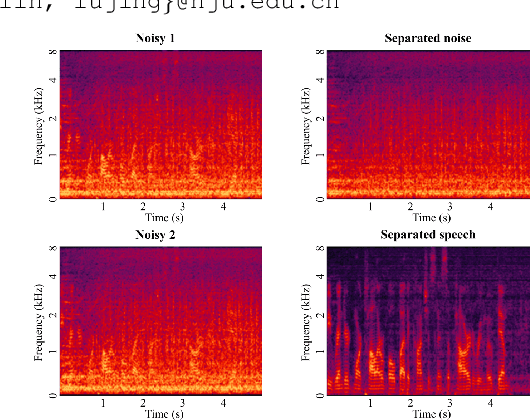



Abstract:Although deep learning based multi-channel speech enhancement has achieved significant advancements, its practical deployment is often limited by constrained computational resources, particularly in low signal-to-noise ratio (SNR) conditions. In this paper, we propose a lightweight hybrid dual-channel speech enhancement system that combines independent vector analysis (IVA) with a modified version of the dual-channel grouped temporal convolutional recurrent network (GTCRN). IVA functions as a coarse estimator, providing auxiliary information for both speech and noise, while the modified GTCRN further refines the speech quality. We investigate several modifications to ensure the comprehensive utilization of both original and auxiliary information. Experimental results demonstrate the effectiveness of the proposed system, achieving enhanced speech with minimal parameters and low computational complexity.
TS-URGENet: A Three-stage Universal Robust and Generalizable Speech Enhancement Network
May 24, 2025Abstract:Universal speech enhancement aims to handle input speech with different distortions and input formats. To tackle this challenge, we present TS-URGENet, a Three-Stage Universal, Robust, and Generalizable speech Enhancement Network. To address various distortions, the proposed system employs a novel three-stage architecture consisting of a filling stage, a separation stage, and a restoration stage. The filling stage mitigates packet loss by preliminarily filling lost regions under noise interference, ensuring signal continuity. The separation stage suppresses noise, reverberation, and clipping distortion to improve speech clarity. Finally, the restoration stage compensates for bandwidth limitation, codec artifacts, and residual packet loss distortion, refining the overall speech quality. Our proposed TS-URGENet achieved outstanding performance in the Interspeech 2025 URGENT Challenge, ranking 2nd in Track 1.
Generating Localized Audible Zones Using a Single-Channel Parametric Loudspeaker
Apr 24, 2025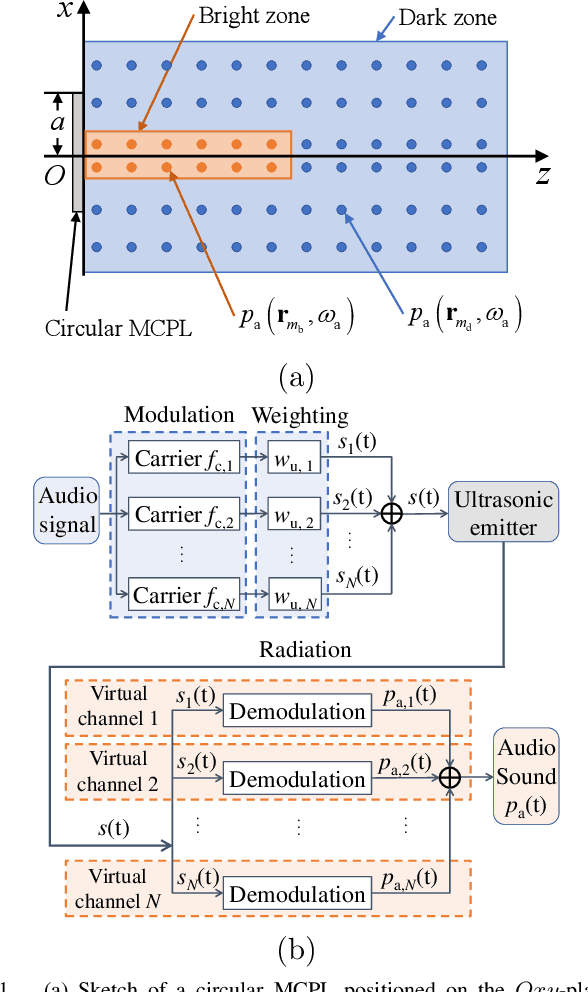
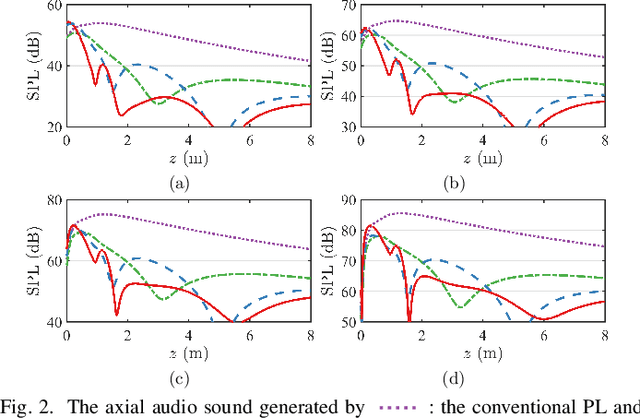
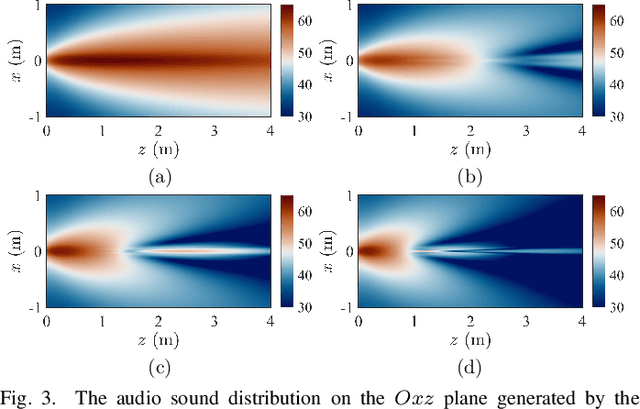
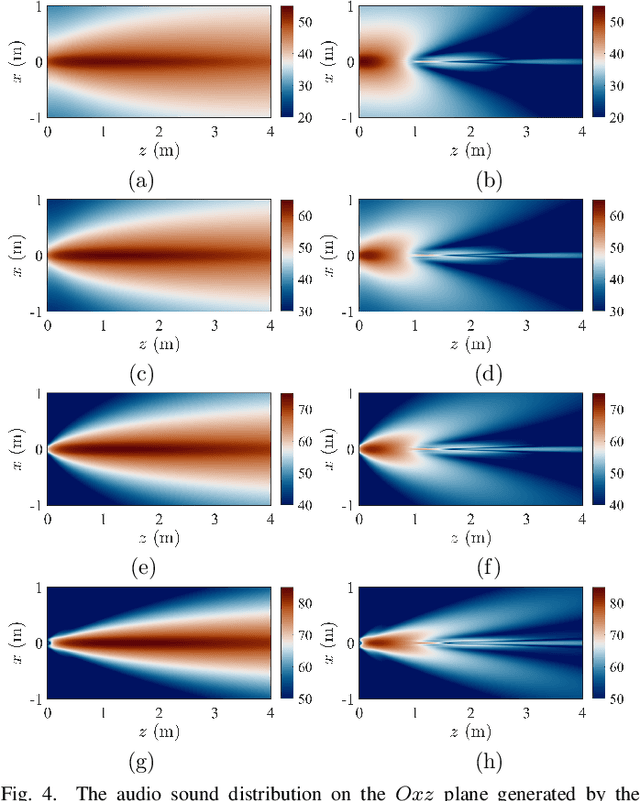
Abstract:Advanced sound zone control (SZC) techniques typically rely on massive multi-channel loudspeaker arrays to create high-contrast personal sound zones, making single-loudspeaker SZC seem impossible. In this Letter, we challenge this paradigm by introducing the multi-carrier parametric loudspeaker (MCPL), which enables SZC using only a single loudspeaker. In our approach, distinct audio signals are modulated onto separate ultrasonic carrier waves at different frequencies and combined into a single composite signal. This signal is emitted by a single-channel ultrasonic transducer, and through nonlinear demodulation in air, the audio signals interact to virtually form multi-channel outputs. This novel capability allows the application of existing SZC algorithms originally designed for multi-channel loudspeaker arrays. Simulations validate the effectiveness of our proposed single-channel MCPL, demonstrating its potential as a promising alternative to traditional multi-loudspeaker systems for achieving high-contrast SZC. Our work opens new avenues for simplifying SZC systems without compromising performance.
WaveNet-Volterra Neural Networks for Active Noise Control: A Fully Causal Approach
Apr 06, 2025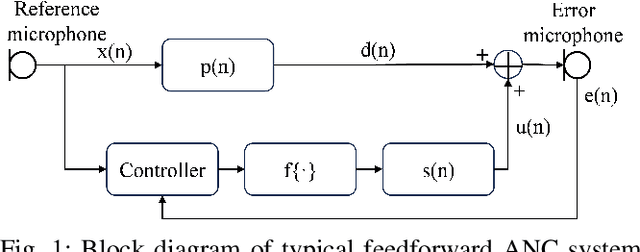
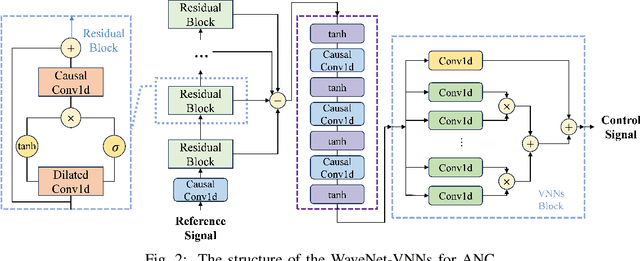
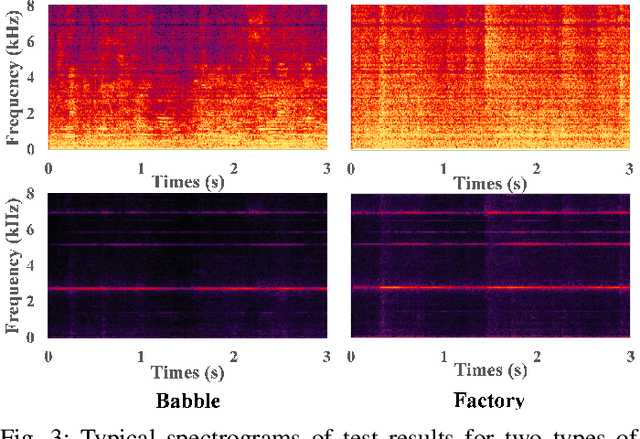

Abstract:Active Noise Control (ANC) systems are challenged by nonlinear distortions, which degrade the performance of traditional adaptive filters. While deep learning-based ANC algorithms have emerged to address nonlinearity, existing approaches often overlook critical limitations: (1) end-to-end Deep Neural Network (DNN) models frequently violate causality constraints inherent to real-time ANC applications; (2) many studies compare DNN-based methods against simplified or low-order adaptive filters rather than fully optimized high-order counterparts. In this letter, we propose a causality-preserving time-domain ANC framework that synergizes WaveNet with Volterra Neural Networks (VNNs), explicitly addressing system nonlinearity while ensuring strict causal operation. Unlike prior DNN-based approaches, our method is benchmarked against both state-of-the-art deep learning architectures and rigorously optimized high-order adaptive filters, including Wiener solutions. Simulations demonstrate that the proposed framework achieves superior performance over existing DNN methods and traditional algorithms, revealing that prior claims of DNN superiority stem from incomplete comparisons with suboptimal traditional baselines. Source code is available at https://github.com/Lu-Baihh/WaveNet-VNNs-for-ANC.git.
FNSE-SBGAN: Far-field Speech Enhancement with Schrodinger Bridge and Generative Adversarial Networks
Mar 17, 2025Abstract:The current dominant approach for neural speech enhancement relies on purely-supervised deep learning using simulated pairs of far-field noisy-reverberant speech (mixtures) and clean speech. However, these trained models often exhibit limited generalizability to real-recorded mixtures. To address this issue, this study investigates training enhancement models directly on real mixtures. Specifically, we revisit the single-channel far-field to near-field speech enhancement (FNSE) task, focusing on real-world data characterized by low signal-to-noise ratio (SNR), high reverberation, and mid-to-high frequency attenuation. We propose FNSE-SBGAN, a novel framework that integrates a Schrodinger Bridge (SB)-based diffusion model with generative adversarial networks (GANs). Our approach achieves state-of-the-art performance across various metrics and subjective evaluations, significantly reducing the character error rate (CER) by up to 14.58% compared to far-field signals. Experimental results demonstrate that FNSE-SBGAN preserves superior subjective quality and establishes a new benchmark for real-world far-field speech enhancement. Additionally, we introduce a novel evaluation framework leveraging matrix rank analysis in the time-frequency domain, providing systematic insights into model performance and revealing the strengths and weaknesses of different generative methods.
Adaptive Convolution for CNN-based Speech Enhancement Models
Feb 20, 2025Abstract:Deep learning-based speech enhancement methods have significantly improved speech quality and intelligibility. Convolutional neural networks (CNNs) have been proven to be essential components of many high-performance models. In this paper, we introduce adaptive convolution, an efficient and versatile convolutional module that enhances the model's capability to adaptively represent speech signals. Adaptive convolution performs frame-wise causal dynamic convolution, generating time-varying kernels for each frame by assembling multiple parallel candidate kernels. A Lightweight attention mechanism leverages both current and historical information to assign adaptive weights to each candidate kernel, guiding their aggregation. This enables the convolution operation to adapt to frame-level speech spectral features, leading to more efficient extraction and reconstruction. Experimental results on various CNN-based models demonstrate that adaptive convolution significantly improves the performance with negligible increases in computational complexity, especially for lightweight models. Furthermore, we propose the adaptive convolutional recurrent network (AdaptCRN), an ultra-lightweight model that incorporates adaptive convolution and an efficient encoder-decoder design, achieving superior performance compared to models with similar or even higher computational costs.
Multi-Center Study on Deep Learning-Assisted Detection and Classification of Fetal Central Nervous System Anomalies Using Ultrasound Imaging
Jan 01, 2025



Abstract:Prenatal ultrasound evaluates fetal growth and detects congenital abnormalities during pregnancy, but the examination of ultrasound images by radiologists requires expertise and sophisticated equipment, which would otherwise fail to improve the rate of identifying specific types of fetal central nervous system (CNS) abnormalities and result in unnecessary patient examinations. We construct a deep learning model to improve the overall accuracy of the diagnosis of fetal cranial anomalies to aid prenatal diagnosis. In our collected multi-center dataset of fetal craniocerebral anomalies covering four typical anomalies of the fetal central nervous system (CNS): anencephaly, encephalocele (including meningocele), holoprosencephaly, and rachischisis, patient-level prediction accuracy reaches 94.5%, with an AUROC value of 99.3%. In the subgroup analyzes, our model is applicable to the entire gestational period, with good identification of fetal anomaly types for any gestational period. Heatmaps superimposed on the ultrasound images not only provide a visual interpretation for the algorithm but also provide an intuitive visual aid to the physician by highlighting key areas that need to be reviewed, helping the physician to quickly identify and validate key areas. Finally, the retrospective reader study demonstrates that by combining the automatic prediction of the DL system with the professional judgment of the radiologist, the diagnostic accuracy and efficiency can be effectively improved and the misdiagnosis rate can be reduced, which has an important clinical application prospect.
 Add to Chrome
Add to Chrome Add to Firefox
Add to Firefox Add to Edge
Add to Edge